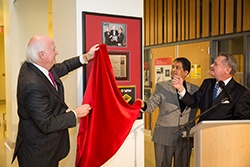University of Arkansas, NanoMech Install Prestigious R&D 100 Award
by December 20, 2013 10:23 am 134 views

NanoMech, a company affiliated with the University of Arkansas, installed its prestigious “Oscar of Innovation” award at the university on Thursday.
The R&D 100 plaque, which signifies NanoMech’s inclusion in R&D Magazine’s 2013 list of the year’s top technological innovations, will be permanently displayed in the UA’s Institute for Nanoscience and Engineering.
“This research was nurtured on the University of Arkansas campus and helped through the commercialization process at the Arkansas Research and Technology Park,” Chancellor G. David Gearhart told the crowd at the event. “New ventures based on university research serve as a key way to keep highly-skilled science, engineering and business graduates right here in Arkansas.”
The magazine based its R&D 100 award – which was announced earlier this year – on Tufftek, which greatly decreases wear, reduces heat resistance and improves precision for cutting tools. The technology behind Tufftek was invented and patented at the University of Arkansas and licensed to NanoMech for its commercialization and continued development.
NanoMech is the only Arkansas company on the 2013 R&D 100. The firm maintains offices at its manufacturing plant and laboratories in Springdale, and at the Arkansas Research and Technology Park, which is managed by the UA Technology Development Foundation.
Jim Phillips, NanoMech’s chief executive officer, emphasized the company’s research partnership with the UA.
“We maintain an outstanding relationship with the University of Arkansas in technology transfer and commercialization,” Phillips said. “The vast majority of our engineers and scientists are University of Arkansas graduates and have trained on the analytical equipment.
“The Institute of Nanoscience and Engineering is a major regional asset to NanoMech as we utilize the vast array of scientific apparatuses and electron microscopes to help advance our technology and industry breakthrough products that increase America’s global manufacturing competitiveness,” he said.
Phillips added that of NanoMech’s 35 employees, 80 percent graduated from the UA. The company is planning to expand by 10 employees in the near future, he said.
Ajay Malshe, a distinguished professor of mechanical engineering at the UA, founded NanoMech in 2002.
In 2005, the UA licensed technology and patents to NanoMech so the company could commercially develop its products.
“NanoMech presented a check for $375,000 in royalty payments to the university at the dedication of this very building two years ago,” Gearhart said. “NanoMech has gone on to pay the U of A nearly $200,000 in royalty payments since then.”
NanoMech’s breakthroughs in nano-materials and manufacturing include the first cubic boron nitride coating for machine tools and advanced nano-engineered lubricants. As an internationally competitive nanomaterials science and manufacturing company, NanoMech’s products have applications in machining and manufacturing, lubrication and energy, sustainable protective coatings for textiles and other consumer products, strategic military applications and biomedical implant functional coatings.
In developing TuffTek and other advanced technologies, NanoMech uses the institute’s scanning electron microscope for surface morphology, cross-sectional analysis and elemental analysis. It uses the institute’s transmission electron microscope for grain/crystal size analysis and elemental analysis. The institute’s X-ray diffraction allows the firm to determine crystal structures/orientation and for estimating crystalline.
The R&D Top 100 list was established in 1963 and over the past 51 years has recognized such revolutionary products as the flashcube (1965), the automated teller machine (1973), the halogen lamp (1974), the fax machine (1975), the liquid crystal display (1980), the Kodak Photo CD (1991) and HDTV (1998).
